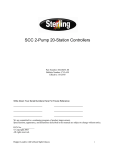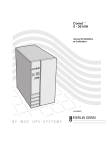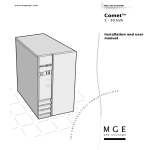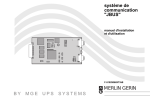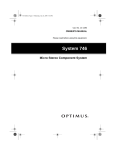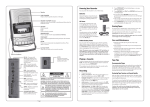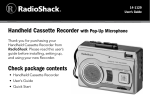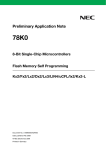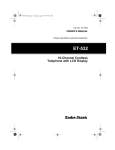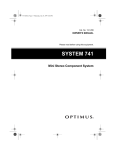Download Optimus SYSTEM 728 User's Manual
Transcript
13-1275.fm Page 1 Wednesday, July 14, 1999 3:59 PM Cat. No. 13-1275 OWNER’S MANUAL Please read before using this equipment. SYSTEM 728 MINI STEREO COMPONENT SYSTEM R 13-1275.fm Page 2 Wednesday, July 14, 1999 3:59 PM FEATURES Your Optimus System 728 Mini Stereo Compnent System is a versatile and high quality sound system. Its components include a 3-disc carousel CD changer with 32-track memory, AM/FM stereo tuner with 20station presets, and dual cassette players with high-speed dubbing. Automatic Search æ lets you quickly select any track on the loaded CDs. You can operate many of the system’s functions with its remote control. The supplied speakers which include 5-inch woofers and tweeters, let you immediately begin using your system. Random Play æ plays all the loaded CD’s tracks in random order. Its features include: Repeat Play æ repeats a single track, all tracks on a single CD, all CDs in the CD compartment, or a programmed sequence. Sequence Track Programming æ lets you program up to 32 tracks to play in any order you choose. 5- or 3-Inch CD Compatible æ lets you play 5- or 3-inch CDs. AM/FM Stereo Tuner Selectable Electronic Graphic Equalizer æ lets you select any of the preset sound characteristic curves (normal, pop, rock, and classic). Preset Tuning Memories æ let you store up to 20 of your favorite stations for quick tuning. Extended Bass æ lets you emphasize low-bass sound. CD Changer Dual Cassette Player Normal or High-Speed Dubbing æ lets you dub tapes at normal or twice normal speed. Consecutive Play æ automatically plays one side of two tapes in sequence. Auto-Stop æ automatically stops the tape when it finishes playing or recording and when it fast-forwards or rewinds to the end of the side. This protects the tape and tape-handling parts. Automatic CD Changer æ lets you load and play up to three CDs. © 1995 Tandy Corporation. All Rights Reserved. Optimus and Radio Shack are registered trademarks used by Tandy Corporation. 2 13-1275.fm Page 3 Wednesday, July 14, 1999 3:59 PM General Auxiliary Input Jacks æ let you connect an external audio input source to your system so you can listen to or record from it. Microphone Mixing æ lets you sing along with the music you are playing. Important: Most material on compact discs and prerecorded tapes is copyrighted. Unauthorized duplication of copyrighted material is a violation of the copyright laws of most countries and such duplication may result in fines and/or imprisonment. Note, however, that in the United States, it is not a violation of U.S. copyright laws for a consumer to use an audio recording device to duplicate musical recordings for noncommercial (personal) use Compact discs that you can play on your system’s CD player have this mark on them. Read this manual carefully. It will help you get the most enjoyment from your system. mend you record your system’s serial number here. Serial Number: Warning: To prevent fire or shock hazard, do not expose this system to rain or moisture. CAUTION RISK OF ELECTRIC SHOCK. DO NOT OPEN. ! CAUTION: TO REDUCE THE RISK OF ELECTRIC SHOCK, DO NOT REMOVE COVER OR BACK. NO USER-SERVICEABLE PARTS INSIDE. REFER SERVICING TO QUALIFIED PERSONNEL. This symbol is intended to alert you to the presence of uninsulated dangerous voltage within the system’s enclosure that might be of sufficient magnitude to constitute a risk of electric shock. Do not open the system’s case. ! This symbol is intended to inform you that important operating and maintenance instructions are included in the literature accompanying this system. Warning: This system uses a laser light beam. Only a qualified service person should remove the cover or attempt to service this device, due to possible eye injury. Your system’s serial number is located on the back panel. We recom- 3 13-1275.fm Page 4 Wednesday, July 14, 1999 3:59 PM FCC INFORMATION This system complies with the limits for a Class B digital device as specified in part 15 of FCC Rules. These limits provide reasonable protection against TV or radio interference in a residential area. However, your system might cause TV or radio interference even when it is operating properly. To eliminate interference, you can try one or more of the following corrective measures. • Reorient or relocate the TV or radio’s receiving antenna. • Increase the distance between the system and the TV or radio. • Use outlets on different electrical circuits for the system and the TV or radio. Consult your local Radio Shack store if the problem still exists. 4 13-1275.fm Page 5 Wednesday, July 14, 1999 3:59 PM CONTENTS Preparation ....................................................................................................... 7 Connecting the Speakers ............................................................................ 7 Connecting an External Audio Source......................................................... 7 Connecting an External Antenna ................................................................. 7 Installing the Remote Control’s Batteries..................................................... 8 Connecting to Power ................................................................................... 8 Operation .......................................................................................................... 9 Turning Power On/Off .................................................................................. 9 Setting the Clock.......................................................................................... 9 Basic Operation ......................................................................................... 10 Using Headphones .................................................................................... 11 Listening Safely ................................................................................... 11 Displaying the Time ................................................................................... 12 Using the Electronic Graphic Equalizer ..................................................... 12 Using the Mute Button ............................................................................... 12 Using the Timer.......................................................................................... 12 Setting the Timer ................................................................................. 12 Turning the Timer On/Off..................................................................... 14 Displaying the Timer............................................................................ 14 Using the Sleep Timer ............................................................................... 15 Using the Remote Control ......................................................................... 15 Using the Tuner .............................................................................................. 16 Manual Tuning ........................................................................................... 16 Automatic Seek Tuning.............................................................................. 17 Memory Tuning .......................................................................................... 17 Storing Stations in Memory ................................................................. 17 Manually Tuning to a Preset Station ................................................... 18 Scanning the Preset Stations .............................................................. 18 Using the CD Changer ................................................................................... 19 Loading a CD............................................................................................. 19 Playing a CD .............................................................................................. 19 Selecting Another CD ................................................................................ 20 Automatic Search ...................................................................................... 20 Random Play ............................................................................................. 20 5 13-1275.fm Page 6 Wednesday, July 14, 1999 3:59 PM Repeat Play ............................................................................................... 21 Repeating a Single Track .................................................................... 21 Repeating All Tracks on a Selected CD .............................................. 21 Repeating All Tracks on All Loaded CDs ............................................ 21 Repeating a Programmed Sequence.................................................. 21 Programmed Play ...................................................................................... 22 Programming and Playing a Sequence of Tracks ............................... 22 Reviewing the Programmed Sequence .............................................. 22 Replacing/Adding a Track in a Programmed Sequence ..................... 23 Clearing the Programmed Sequence .................................................. 23 Using the Cassette Deck ............................................................................... 24 Loading a Cassette Tape ........................................................................... 24 Playing a Cassette Tape............................................................................ 24 Using Consecutive Play............................................................................. 25 Recording .................................................................................................. 25 Dubbing Cassette Tapes ..................................................................... 25 Copying a CD to a Cassette Tape....................................................... 26 Recording from the Tuner or an External Audio Source ..................... 27 Timer Recording.................................................................................. 28 Microphone Mixing ........................................................................................ 29 Care and Maintenance ................................................................................... 30 CD Care Tips ............................................................................................. 31 Tape Tips ................................................................................................... 31 Erasing a Cassette Tape ..................................................................... 31 Preventing Accidental Erasure............................................................ 31 Restoring Tape Tension and Sound Quality ........................................ 32 Cleaning the Tape Handling Parts ...................................................... 32 Specifications................................................................................................. 33 6 13-1275.fm Page 7 Wednesday, July 14, 1999 3:59 PM PREPARATION Note: Complete all connections before connecting to AC power and turning it on. CONNECTING AN EXTERNAL AUDIO SOURCE CONNECTING THE SPEAKERS To connect an external audio source (such as a CD player or a cassette deck) to your system, connect the source’s left and right line level output jacks to the AUX IN R and L jacks on the back of your system. CONNECTING AN EXTERNAL ANTENNA 1. Press the red speaker terminal tab labeled SPEAKER R. Ch + on the back of the system, insert the stripped end of the right speaker’s striped wire into the terminal, then release the tab. 2. Press the black speaker terminal tab labeled SPEAKER R. Ch on the back of the system, insert the stripped end of the right speaker’s other wire into the terminal, then release the tab. 3. Repeat Steps 1 and 2 to connect the left speaker to SPEAKER L. Ch + and - terminals. You can attach an FM or VHF antenna (not supplied) to the 300 ohm EXT. ANT. terminals on the back of the system. If you have an outside VHF TV antenna, you can use a signal splitter with a 300-ohm output to connect your stereo system and TV set to the same antenna. Your local Radio Shack store has a wide selection of antennas, connectors, and splitters. 7 13-1275.fm Page 8 Wednesday, July 14, 1999 3:59 PM INSTALLING THE REMOTE CONTROL’S BATTERIES The remote control requires two AA batteries (not supplied) for power. We recommend alkaline batteries, such as Radio Shack Cat. No. 23557. 3. Replace the cover. Caution: If you are not going to use the remote control for a month or more, remove its batteries. Weak batteries can leak damaging chemicals. Note: If the remote control operates erratically or does not work, replace both batteries. Follow these steps to install batteries. 1. Press down and slide the battery compartment cover in the direction of the arrow. CONNECTING TO POWER After you complete all connections, plug the music system’s supplied power cord into a standard AC outlet. The STAND BY indicator lights, and CLO and AM 12:00 appear on the display (see “Setting the Clock”). 2. Install the batteries as indicated by the polarity symbols (+) and (-) marked inside the compartment. 8 Warning: To prevent electric shock, the AC power cord plug’s blades are polarized and fit a polarized AC outlet only one way. If you have difficulty inserting the plug, do not force it. Turn it over and reinsert it. 13-1275.fm Page 9 Wednesday, July 14, 1999 3:59 PM OPERATION TURNING POWER ON/ OFF Warning: To protect your hearing, set VOLUME to MIN before you turn on the system. SETTING THE CLOCK 1. If necessary, press DISPLAY so CLO and the time appear on the display. 2. Press MEMORY. CLO on the display. flashes Press POWER to turn on the system. The STAND BY indicator turns off and the indicator above CD, TUNER, TAPE, or AUX lights. 〉 〈 Note: If you do not press TUNor within 10 seconds after you press MEMORY, CLO stops flashing on the display. Start again from Step 2. ING Notes: 〈 〈 3. While CLO flashes, repeatedly press TUNING to set the desired hour. If you press and hold down TUNING , the hour advances continuously. Note: AM or PM appears when you set an AM or PM hour. • If the indicator above TUNER appears, the AM or FM station previously selected appears on the display. 4. While CLO flashes, repeatedly to set the press TUNING desired minutes. If you press and hold down TUNING , the minutes advance continuously. 〉 〉 • If the indicator above CD, TAPE, or AUX appears, CLO and the time appear on the display. 5. Press MEMORY again when you finish setting the time, or just wait 10 seconds. 9 13-1275.fm Page 10 Wednesday, July 14, 1999 3:59 PM BASIC OPERATION Follow these steps to operate your system. 4. Adjust BALANCE until you can hear the sound equally from the left and right speakers. 1. Press CD, TUNER, TAPE, or AUX to select the desired audio source. 5. Select the desired equalization by pressing NORMAL, POP, ROCK, or CLASSIC (see “Using the Electronic Graphic Equalizer”). 2. If you select TUNER, select the desired station (see “Using the Tuner”). If you select CD, TAPE, or AUX, start the selected audio source (see “Using the CD Changer” or “Using the Cassette Deck”). 3. Adjust VOLUME to a comfortable listening level. 10 6. Press E-BASS to emphasize bass sounds. To return to normal bass sounds, press E-BASS again. 7. To turn off the system, press POWER so the STAND BY indicator lights. 13-1275.fm Page 11 Wednesday, July 14, 1999 3:59 PM USING HEADPHONES Listening Safely You can use headphones (not supplied) to listen in privacy. Insert the headphones’ 1/8-inch (3.5 mm) plug into the PHONES jack. To protect your hearing, follow these guidelines when you use headphones. • Do not listen at extremely high volume levels. Extended highvolume listening can lead to permanent hearing loss. • Set the volume to the lowest setting before you begin listening. After you begin listening, adjust the volume to a comfortable level. Notes: • Your local Radio Shack store sells a wide selection of headphones. • Once you set the volume, do not increase it. Over time, your ears adapt to the volume level, so a volume level that does not cause discomfort might still damage your hearing. • Connecting headphones automatically disconnects the speakers. 11 13-1275.fm Page 12 Wednesday, July 14, 1999 3:59 PM DISPLAYING THE TIME To display the clock while you use the radio, press DISPLAY. To return to the radio display, press DISPLAY again. USING THE ELECTRONIC GRAPHIC EQUALIZER You can select any one of four preset sound characteristics using the system’s electronic graphic equalizer. Each setting distinctly changes the music’s character or tone. Setting Sound NORMAL Normal sound POP More presence of vocals and midrange ROCK Powerful sound emphasizing treble and bass CLASSIC Sound enriched with heavy bass and fine treble 12 USING THE MUTE BUTTON The MUTE button lets you temporarily turn off the sound. Press MUTE once to turn it off. Press MUTE again to restore sound. USING THE TIMER You can set the timer to automatically turn on the system, play from the tuner or a cassette tape (not from a CD), then turn off the system. Note: You can use the system while the timer is set. Setting the Timer 1. While the current time appears on the display, press 1. TIM ON flashes on the display. Note: If TUNER is selected, press DISPLAY first so the current time appears on the display. 13-1275.fm Page 13 Wednesday, July 14, 1999 3:59 PM 〈 〉 Note: If you do not press TUNING or within 10 seconds after you press 1, TIM ON disappears from the display. Start again from Step 1. 〈 2. While TIM ON flashes, repeatedly press TUNING to set the hour of the desired start time. 4. Press 2. TIM OFF flashes on the display. 〈 5. While TIM OFF flashes, repeatedly press TUNING to set the hour of the desired end time. Notes: 〈 • Press and hold down TUNING to continuously advance the hour. • AM or PM appears when you set an AM or PM hour. • AM or PM appears when you set an AM or PM hour. 〉 3. While TIM ON continues to flash, repeatedly press TUNING to set the minutes of the desired start time. 〉 Note: Press and hold down TUNING to continuously advance the minutes. 6. While TIM OFF continues to flash, repeatedly press TUNING to set the minutes of the desired end time. Note: Press and hold down TUNING to continuously advance the minutes. 〉 〈 • Press and hold down TUNING to continuously advance the hour. 〉 Notes: 7. When you finish setting the alarm timer, press DISPLAY to return to the current time display, or wait 10 seconds for the system to automatically return to the current time display. 13 13-1275.fm Page 14 Wednesday, July 14, 1999 3:59 PM Turning the Timer On/Off 1. Press TUNER or TAPE to select the desired audio source. To turn off the timer, simply press TIMER again. Notes: 2. If you selected TUNER, select the desired station (see “Using the Tuner”) and adjust VOLUME to a comfortable listening level. • The system’s controls do not work when TIMER is pushed to on. To operate the system, you must turn off the timer. If you selected TAPE, insert the desired tape, press PLAY, and adjust VOLUME to a comfortable listening level (see “Using the Cassette Deck”). • If you played a cassette tape with the timer, and the timer turns the system off before the tape ends, press STOP/EJECT as soon as possible to release the tape from the mechanism. 3. Press TIMER to turn on the timer. The system turns off. When the selected start time appears on the display, the system automatically turns on, plays, and turns off at the selected end time. The system turns on again the next day at the set start time. 14 Displaying the Timer To display the timer’s start time, press 1 so TIM ON and the start time appear for 10 seconds. To display the timer’s finish time, press 2 so TIM OFFand the finish time appear for 10 seconds. 13-1275.fm Page 15 Wednesday, July 14, 1999 3:59 PM USING THE SLEEP TIMER USING THE REMOTE CONTROL You can set the system to play up to 90 minutes, then automatically turn off. The remote control’s buttons have the same functions as the corresponding buttons on the main system. 1. Press CD, TUNER, TAPE, or AUX to select the desired audio source. 2. Tune to the desired AM or FM radio station, or start the selected CD, tape, or your external audio source. To use the remote control, point it toward the remote sensor on the left of the system’s AM/FM STEREO RECEIVER display and press the desired buttons. 3. Press POWER to turn off the system. 4. To turn on the sleep timer, press and release SLEEP. SLE and 90 appear on the display. To set the sleep timer to a sleep time, press and hold down SLEEP until the desired sleep time appears on the display. The displayed sleep time decreases in 10-minute steps. The system turns itself off after the amount of time you selected. To turn off the sleep timer sooner, press SLEEP again so SLE disappears from the display. Notes: • Make sure you have a clear path between the remote control and the sensor. • Weak batteries or direct sunlight on the remote sensor might reduce the remote control’s operating range. 15 13-1275.fm Page 16 Wednesday, July 14, 1999 3:59 PM USING THE TUNER Press TUNER to use the system’s tuer. The indicator above TUNER lights. Notes: • The system uses a built-in ferrite antenna for AM reception. For the best AM reception, rotate the system. • For the best FM reception, see “Connecting an External FM Antenna.” You can tune to AM or FM radio stations using manual, seek, or memory tuning. MANUAL TUNING • Press it in to select stereo. The FM STEREO indicator lights when you receive an FM broadcast in stereo. • Press it out to select monaural. The sound is no longer in stereo, but reception should improve. If you selected AM, press it in or out to the position that gives the best reception. or 3. Repeatedly press TUNING to tune up or down the selected band. If you press and hold down TUNING or , the stereo tunes quickly. 16 〈 〉 〈 1. Press BAND to select the desired AM or FM band. AM or FM appears on the display. If you selected FM: 〉 Note: When you select TUNER, the system automatically tunes to the station that was playing when the system was turned off or when it was last set to TUNER. 2. Use FM MODE/AM BEAT to select the desired AM or FM band’s mode. 13-1275.fm Page 17 Wednesday, July 14, 1999 3:59 PM AUTOMATIC SEEK TUNING 1. Press BAND to select the desired AM or FM band. AM or FM appears on the display. 2. Using either manual or automatic seek tuning, select the station you want to store, then press MEMORY. 2. Press TUNING AUTO. The system automatically searches up the band and stops when it finds the next strong station. 3. While MEM- appears on the display, follow these guidelines to store up to 10 stations in memory. MEMORY TUNING You can store up to 10 AM and 10 FM stations in memory. Storing Stations in Memory Note: You can assign one frequency to each memory location. When you assign another frequency to the same memory location, the new frequency replaces the first one. Note: You must store a station within 3 seconds. If MEM- disappears before you make the following entries, simply repeat this step. • To store stations into memory locations 1-5, press a memory location button (1-5). The station is stored, MEM- disappears, and the display shows the frequency. 1. Press BAND to select the desired AM or FM band. AM or FM appears on the display. 17 13-1275.fm Page 18 Wednesday, July 14, 1999 3:59 PM • To store stations into memory locations 6-10, press +5 then a memory location button (15). The station is stored, MEM- disappears, and the display shows the frequency. Note: This increases the memory location number by 5. For example, if you press +5, then press memory location button 2, the radio stores the frequency you selected into memory location 7. (illus - show the baloon pointing at the +5 button 4. Repeat Steps 1-3 to program stations in the other band. Manually Tuning to a Preset Station Press the desired memory location button (1 through 5) to directly select a radio station stored in memory. For preset stations 6 through 10, press +5 then the desired memory location button. 18 Scanning the Preset Stations Press M/SCAN. The system scans the preset stations and plays each station for 5 seconds. Note: Repeatedly press M/SCAN to quickly step through the stored stations. To stop scanning at a desired station, within 5 seconds after the tuner stops on that station, press DISPLAY or that station’s memory location button. 13-1275.fm Page 19 Wednesday, July 14, 1999 3:59 PM USING THE CD CHANGER LOADING A CD 1. Press CD . PLAYING A CD To play a CD, simply press PLAY/ PAUSE after you load it. The selected t CD begins to play from Track 1. The display shows , the current tray number, the CD’s current track number, the track’s elapsed time, and the current track number indicator flashes. The system plays all the loaded CDs once. Notes: ∇ ∇ • After you load a CD, do not press either SKIP. or before the track number indicators appear on the display. Otherwise NO DISC appears on the display and you must reset the CD player by pressing OPEN/ CLOSE twice (to open and then close the CD compartment.) Note: The CD carousel has three trays, each labeled with a number, but only two trays show at a time when you open the CD compartment. 3. Place a CD in either (or both) of the exposed trays, label side up. Note: To load a CD in the third tray, press CD SKIP. The carousel rotates, exposing the other tray. 4. After you load the CDs, press OPEN/CLOSE to close the CD compartment. The system displays the current tray number, and the total number of tracks and total playing time of the CD in the tray. ∇ ∇ 2. Press OPEN/CLOSE to open the CD compartment. • If a tray does not contain a CD, the system skips that tray and automatically plays the CD in the next tray. • To temporarily stop play, press PLAY/PAUSE. y ap-pears, the elapsed timer stops counting, and the current track number indicator flashes on the display. To resume play, press PLAY/ PAUSE again. To stop play, press STOP. 19 13-1275.fm Page 20 Wednesday, July 14, 1999 3:59 PM SELECTING ANOTHER CD To select another CD, press CD SKIP before or during play. If the system is playing a CD, it stops playing it and begins playing the first track of the selected CD. RANDOM PLAY This feature randomly selects and plays tracks from all loaded CDs. Note: To randomly select tracks from only one or two CDs, you must load only those CDs in the CD tray. 1. Press STOP to cancel any CD function. AUTOMATIC SEARCH The Automatic Search feature lets you quickly locate the beginning of any track on a CD, including the track currently playing. You can use Automatic Search when a CD is playing or stopped. RANDOM. RANDOM 2. Press appears on the display. If a CD is playing: ∇ ∇ SKIP once to skip • Press back to the beginning of the current track. ∇ ∇ SKIP to • Repeatedly press skip backward to the beginning of the desired track. ∇ ∇ to • Repeatedly press SKIP skip forward to the beginning of the desired track. ∇ ∇ 20 ∇ ∇ If the CD is stopped, repeatedly SKIP until press SKIP or the display shows the number of the track you want to play, then press PLAY/PAUSE . The CD player starts playing the selected track. 3. Press PLAY/PAUSE. After one track plays, the system randomly selects another track and plays it and then continues until all tracks on all loaded CDs are played. 13-1275.fm Page 21 Wednesday, July 14, 1999 3:59 PM Notes: ∇ ∇ ∇ ∇ • To repeat the current track, SKIP. To play the press next random track, press SKIP . Repeating All Tracks on a Selected CD • To repeat random play, before the last track ends, press REPEAT until REPEAT ALL appears on the display. • To stop random play, press STOP then RANDOM. RANDOM disappears from the display. To repeat all tracks on a selected CD, press CD SKIP to select the desired CD. Then repeatedly press REPEAT until REPEAT ONE DISC appears. Repeating All Tracks on All Loaded CDs To repeat all tracks on all loaded CDs, repeatedly press REPEAT until REPEAT ALL DISC appears. REPEAT PLAY You can repeat a single track on a selected CD, all tracks on a selected CD, all tracks on all loaded CDs, or a programmed sequence. Note: To cancel repeat play at any time, repeatedly press REPEAT until REPEAT disappears from the display. Repeating a Programmed Sequence To repeat a programmed sequence, press REPEAT while the programmed sequence is playing. REPEAT ALL appears, and the CD player continuously replays the programmed sequence. Repeating a Single Track To repeat a single track, press REPEAT once while the desired track is playing. REPEAT ONE appears on the display, and the CD player continuously replays the track. 21 13-1275.fm Page 22 Wednesday, July 14, 1999 3:59 PM You can program up to 32 tracks from any loaded CDs to play in any order you choose. Programming and Playing a Sequence of Tracks 1. Press STOP to cancel any CD function. 7. Press PLAY/PAUSE . The CD player plays the tracks in the programmed order. MEMORY, the tray number, the current track number, and the track’s elapsed time appear on the display. Notes: • During play, briefly press or SKIP or repeatedly press SKIP as required, to select a previous or a following programmed track. ∇ ∇ 2. Press PROGRAM. The display shows MEMORY - - - P-01 (the current position in the programmed sequence). than 32 tracks, the new track replaces the 32nd track. ∇ ∇ PROGRAMMED PLAY • You cannot use random play or display the CD’s remaining time while a programmed sequence is stored. 3. Press CD SKIP to select the CD containing the tracks you want to store. ∇ ∇ ∇ ∇ SKIP or SKIP 4. Press to select the CD’s track number you want to store. 5. Press PROGRAM. The track is stored and the display shows MEMORY - - - P-02. 6. Repeat Steps 3–5 to program additional tracks. Note: FULL appears on the display after you store the 32nd track. If you try to program more 22 • Pressing CD SKIP has no effect while a programmed sequence plays. Reviewing the Programmed Sequence While play is stopped, repeatedly press PROGRAM to review the programmed sequence. 13-1275.fm Page 23 Wednesday, July 14, 1999 3:59 PM Replacing/Adding a Track in a Programmed Sequence 1. While play is stopped, repeatedly press PROGRAM until the track position number you want to replace or add to appears on the display. 2. Press CD SKIP to select the CD containing the new track. ∇ ∇ ∇ ∇ SKIP or SKIP 3. Press until the desired track appears on the display. 4. Press PROGRAM. The new track replaces a previous track or is added to the programmed sequence. Clearing the Programmed Sequence To clear the entire programmed sequence, press STOP while play is stopped, or press OPEN/CLOSE . 23 13-1275.fm Page 24 Wednesday, July 14, 1999 3:59 PM USING THE CASSETTE DECK The system has two cassette decks. You can use Deck 1 for normal playback, consecutive play, and dubbing (recording). You can use Deck 2 for normal playback and consecutive play. Both decks (1 and 2) have a full-release auto-stop system to protect tapes and prevent pinch roller damage. When a tape reaches the end while playing, recording, fast-forwarding, or rewinding, the tape mechanism automatically stops. LOADING A CASSETTE TAPE 3. Load the cassette by placing it in the tape guides in the cassette compartment door, with its open edge down, the desired side facing out, and its full reel to the left. 4. Gently close the compartment door. PLAYING A CASSETTE TAPE Warning: To protect your hearing, set VOLUME to its lowest setting before you begin playing a cassette tape. Notes: • Use the control buttons under the same deck where you loaded the tape. • Before loading a cassette tape, take up any slack in the tape by turning one of the cassette’s hubs with a pencil. If you do not remove excess slack, the tape might become tangled in the record/playback mechanism. Follow these steps to play a cassette tape in either Deck 1 or Deck 2. 1. Load the cassette. Follow these steps to load a cassette tape in either Deck 1 or Deck 2. 1. Press TAPE . The TAPE indicator lights. 2. Press STOP/EJECT on either Deck 1 or Deck 2 to open the cassette compartment door. 24 2. Press PLAY on the deck you are using. The tape plays until it reaches the end of the side, then it automatically stops. 3. Adjust VOLUME to the desired listening level. 13-1275.fm Page 25 Wednesday, July 14, 1999 3:59 PM 4. To fast-forward or rewind the tape, press STOP/EJECT then press FAST-F or REWIND on the deck you are using. To temporarily stop playback, press PAUSE on the deck you are using. Press PAUSE again to continue playback. To stop playback, fast-forward, or rewind, press STOP/EJECT on the deck you are using. 5. To open the cassette compartment and remove the cassette tape, press STOP/EJECT while the cassette player is stopped. USING CONSECUTIVE PLAY You can set the tape player to play one side of a tape in Deck 2, then automatically play one side of a tape in Deck 1. RECORDING Notes: • Be sure the erase-protection tab for the cassette you want to record on is in place (see “Preventing Accidental Erasure”). • The recording level is preset. Adjusting E-BASS, the graphic equalizer, or VOLUME does not affect the recording level or quality. Dubbing Cassette Tapes You can easily copy a tape by playing it in Deck 2 and recording it onto another tape in Deck 1. You can select between normal and high-speed dubbing, and you can monitor the tape as you dub it. 1. Load the cassette you want to copy from into Deck 2 and a blank cassette, or one you want to record over, into Deck 1. 1. Load the cassette you want to hear first in Deck 2 and the second cassette in Deck 1. 2. Press PLAY on Deck 2. The cassette in Deck 2 plays. 3. While the cassette in Deck 2 is playing, press PAUSE then PLAY on Deck 1. When the cassette in Deck 2 finishes playing, the cassette in Deck 1 automatically begins playback. 25 13-1275.fm Page 26 Wednesday, July 14, 1999 3:59 PM 2. To record at normal speed for the best quality sound, set HIGH SPEED DUBBING to OFF. To record in half the normal recording time, set HIGH SPEED DUBBING to ON. 3. On Deck 1, press PAUSE then RECORD . PLAY on Deck 1 automatically locks down. Caution: Do not force down RECORD . This can damage the recording mechanism. 4. On Deck 2, press PLAY. PAUSE on Deck 1 releases and the system copies the tape in Deck 2 onto the tape in Deck 1. Copying a CD to a Cassette Tape Follow these steps to copy the tracks from the loaded CDs to a cassette tape in Deck 1. 1. On Deck 1: • Load a blank cassette tape, or one you want to record over. • Press PLAY and let the tape play for about 5 seconds so it plays past the tape leader. • Press STOP/EJECT to stop the tape. Notes: • Press PAUSE then RECORD. • To monitor the tape while it is copying, adjust VOLUME to a comfortable listening level. Caution: Do not force down RECORD. This can damage the recording mechanism. • If you monitor the tape while high-speed dubbing, the sound is distorted. 2. Press CD to select the CD player. 5. To stop copying, press STOP/ EJECT on Deck 1 and Deck 2. 26 When the tape in either deck reaches the end, that deck automatically turns off. If the cassette in the other deck has not run out of tape, that tape continues to record or play. If you were using high-speed dubbing, the continuing tape plays/records at normal speed (instead of high speed). 3. Press OPEN/CLOSE to open the CD compartment, then load the desired CDs in the CD player. 13-1275.fm Page 27 Wednesday, July 14, 1999 3:59 PM Notes: • To copy a programmed sequence, store the desired sequence before continuing with Step 4. • To copy a CD’s tracks in random sequence, press RANDOM so RANDOM appears on the display before continuing with Step 4. 4. Simultaneously press PAUSE on Deck 1 and PLAY/PAUSE on the CD player. The system records from the CD onto the cassette tape. 5. To stop recording before it automatically stops, press STOP on the CD player, then press STOP/ EJECT on Deck 1. Recording from the Tuner or an External Audio Source Follow these steps to record from the tuner or from an external audio source connected to the system, such as a VCR or other audio/video equipment. 1. On Deck 1: • Load a blank cassette tape, or one you want to record over. • Press PLAY and let the tape play for about 5 seconds so it plays past the tape leader. • Press STOP/EJECT to stop the tape. • Press PAUSE then RECORD. Caution: Do not force down RECORD. This can damage the recording mechanism. 2. Press TUNER or AUX to select the desired audio source. 3. Select the desired station or start the selected audio source, then press PAUSE on Deck 1. The cassette records until it reaches the end of the side, then it automatically stops. 4. To stop recording before it automatically stops, press STOP/ EJECT on Deck 1. 27 13-1275.fm Page 28 Wednesday, July 14, 1999 3:59 PM Timer Recording You can set the system to automatically turn itself on, record from a selected audio source (such as the tuner or a cassette tape in Deck 2) onto a cassette tape in Deck 1, then turn itself off at the time you set. 1. Repeat Steps 1-7 in “Using the Timer,” to set the start and end times and select the source you want to record from. 2. On Deck 1: • Load a blank cassette tape, or one you want to record over. • Press PLAY and let the tape play for about 5 seconds so it plays past the tape leader. • Press STOP/EJECT to stop the tape. • Press PAUSE then RECORD. Caution: Do not force down RECORD . This can damage the record mechanism. 3. Press TIMER to turn on the timer. 4. Press PAUSE on Deck 1. At the preset time, the system turns itself on and records onto the cassette in Deck 1 until the end time is reached. 28 Caution: If the cassette’s length is longer than the timer recording period, RECORD and PLAY stay locked down when the timer turns off. To prevent accidental tape tangling, press STOP/EJECT on Deck 1 as soon as possible after the timer turns off. To turn off the timer, press TIMER until TIM ON OFFdisappears from the display. If the tape length is longer than the timer setting, press STOP/ EJECT on Deck 1. 13-1275.fm Page 29 Wednesday, July 14, 1999 3:59 PM MICROPHONE MIXING Using an external microphone with a 1 /8-inch plug (not supplied), you can sing along with selections on CDs or cassette tapes, or with a song played over the radio. Warning: To prevent damage to your hearing, set VOLUME to its minimum level before you turn on the system. Note: Your local Radio Shack sells a wide selection of microphones. 1. Connect an external microphone to the MIC MIX jack. 3. Select the desired station or start the selected audio source. 4. Adjust VOLUME to a comfortable listening level. Note: The microphone input jack does not have an individual volume control. 5. Sing or talk into the microphone. The system mixes your voice with the selected audio source. To record your voice and the audio source mixed together onto a cassette tape, follow the steps in “Copying a CD to a Cassette Tape” or “Recording from the Tuner or an External Audio Source.” When you finish mixing, remove the microphone’s plug from the MIC MIX jack. 2. Press CD, TUNER, TAPE, or AUX to select the desired audio source. 29 13-1275.fm Page 30 Wednesday, July 14, 1999 3:59 PM CARE AND MAINTENANCE Your Optimus System 728 Mini Stereo Compnent System is an example of superior design and craftsmanship. The following suggestions will help you care for the system so you can enjoy it for years. Keep the system dry. If it gets wet, wipe it dry immediately. Liquids might contain minerals that can corrode the electronic circuits. Handle the system gently and carefully. Dropping it can damage circuit boards and cases and can cause the system to work improperly. Use and store the system only in normal temperature environments. Temperature extremes can shorten the life of electronic devices and distort or melt plastic parts. Keep the system away from dust and dirt, which can cause premature wear of parts. CLEANER Wipe the system with a damp cloth occasionally to keep it looking new. Do not use harsh chemicals, cleaning solvents, or strong detergents to clean the system. Modifying or tampering with the system’s internal components can cause a malfunction and might invalidate your system’s warranty and void your FCC authorization to operate it. If your system is not performing as it should, take it to your local Radio Shack store for assistance. 30 13-1275.fm Page 31 Wednesday, July 14, 1999 3:59 PM CD CARE TIPS Even though a compact disc is very durable, treat the CD surface with care. We recommend the following precautions: • Do not write on either side of the CD, particularly the non-label side (signals are read from the non-label side). • Do not store CDs in high temperature, high-humidity locations. They might warp. • Keep CDs dry. A water drop can act as a lens and affect the laser beam’s focus. • Always handle a CD by the edges to avoid fingerprints and always keep it in its protective case or sleeve when it is not in use. Fingerprints and scratches on the CD’s surface can prevent the laser beam from correctly reading the digital information. If the CD gets scratched, use Scratch n’ Fix (Radio Shack Cat. No. 42-127). TAPE TIPS You can quickly erase both sides of a cassette tape using a bulk tape eraser (such as Cat. No. 44-232, not supplied), available at your local Radio Shack store. Preventing Accidental Erasure Cassette tapes have two erase-protection tabs æ one for each side. To protect a recording from being accidentally recorded over or erased, use a screwdriver to remove one or both of the cassette tape’s eraseprotection tabs. (Needs an illus - show an erase protection tab beig removed with a screwdriver. If you want to record on a tape side after you have removed the eraseprotection tab, place a piece of strong plastic tape over that side’s erase-protection hole. Be sure you cover only the hole originally covered by the erase-protection tab. Erasing a Cassette Tape To erase a previously recorded section of a tape, simply record over it. To erase the entire cassette tape, let the tape record to the end with no source palying. Note: Removing the erase-protection tabs does not prevent a bulk eraser from erasing a cassette tape. 31 13-1275.fm Page 32 Wednesday, July 14, 1999 3:59 PM Restoring Tape Tension and Sound Quality After you play a cassette tape several times, the tape might become tightly wound on the reels. This can cause playback sound quality to deteriorate. To restore the sound quality, fast-forward the tape from the beginning to the end of one side, then completely rewind it. Then loosen the tape reels by gently tapping each side of the cassette’s outer shell on a flat surface. 1. Disconnect power. 2. Open the cassette compartment doors. 3. Press PLAY on both decks to expose the tape-handling parts. 4. Use a cotton swab dipped in denatured alcohol or tape head cleaning solution to clean the record/play head, pinch roller, capstan, and erase head. Caution: Be careful not to damage the cassette when tapping it. Do not touch the exposed tape or allow any sharp objects near the cassette. Cleaning the Tape Handling Parts Dirt, dust or particles of the tape’s coating can accumulate on the tape heads and other parts that the tape touches. This can greatly reduce the performance of the cassette player. Use the following cleaning procedure after every 20 hours of tape player operation. Your local Radio Shack store sells a wide selection of cassette cleaning supplies. 32 5. When you finish cleaning, press STOP/EJECT on both decks and close the cassette compartment doors. 13-1275.fm Page 33 Wednesday, July 14, 1999 3:59 PM SPECIFICATIONS Cassette Tape Speed .......................................................................................4.75 cm/sec Wow and Flutter ............................................................................ 0.35% WRMS Frequency Response ......................................................... 125 Hz–8 kHz ± 4 dB Recording System ................................................................................... AC Bias Erase System ....................................................................................... Magnetic CD Player Number of Tracks to be Programmed .................................................. 32 Tracks Frequency Response ......................................................... 40 Hz–16 kHz ± 3 dB Dynamic Range...........................................................................................85 dB Signal-to-Noise............................................................................... (JIS-A) 75 dB Harmonic Distortion (at 1 kHz) .....................................................................0.5% Separation (at 1 kHz) ..................................................................................50 dB Sampling Frequency .............................................................................. 44.1 kHz Quantization Number ..................................................................................16 Bit Oversampling .......................................................................................... 2 Times Pick-Up System.............................................................................Sanyo SF-91P Optical Source............................................................................... Sanyo SF-901 Wavelength ............................................................................................. 790 nm 33 13-1275.fm Page 34 Wednesday, July 14, 1999 3:59 PM General Speaker Impedance .................................................................................8 Ohms Power Output .....................................................................10 Watts per Channel Dimensions of Unit ...................................... 143/16 × 117/16 × 145/16 Inches (HWD) (360 × 288 × 338 mm) Dimensions of Each Speaker....................... 143/16 × 713/16 × 611/16 Inches (HWD) (360 × 200 × 175 mm) Weight ................................................................................... 27 lbs 5 oz (12.4 kg Power Supply ................................................................... 120V AC, 60 Hz, 48 W Tuning Range.........................................................................AM: 530–1710 kHz FM: 88–108 MHz Speaker Size...........................................................................................5 Inches Specifications are typical; individual units might vary. Specifications are subject to change and improvement without notice. 34 13-1275.fm Page 35 Wednesday, July 14, 1999 3:59 PM NOTES 35 13-1275.fm Page 36 Wednesday, July 14, 1999 3:59 PM RADIO SHACK LIMITED WARRANTY This product is warranted against defects for 90 days from date of purchase from Radio Shack company-owned stores and authorized Radio Shack franchisees and dealers. Within this period, we will repair it without charge for parts and labor. Simply bring your Radio Shack sales slip as proof of purchase date to any Radio Shack store. Warranty does not cover transportation costs. Nor does it cover a product subjected to misuse or accidental damage. EXCEPT AS PROVIDED HEREIN, RADIO SHACK MAKES NO EXPRESS WARRANTIES AND ANY IMPLIED WARRANTIES ARE LIMITED IN DURATION TO THE DURATION OF THE WRITTEN LIMITED WARRANTIES CONTAINED HEREIN. Some states do not permit limitation or exclusion of implied warranties; therefore, the aforesaid limitation(s) or exclusion(s) may not apply to the purchaser. This warranty gives you specific legal rights and you may also have other rights which vary from state to state. We Service What We Sell 9/94 RADIO SHACK A Division of Tandy Corporation Fort Worth, Texas 76102 7A5 Printed in Hong Kong





































